Art
Advertising
- Advertising
- Tin (Cassiterite) Distribution: Mediterranean Bronze Age
- Archaeological Sites of the Aegean Minoans
- Extent of Santorini Eruption's Tsunami Inundation of Minoan Crete
- End of Minoan Linear A Writing and LM IB Fire Destruction of Crete
-
The Cause of the End of the Bronze Age
with the Scientific Method -
Nature Geoscience Journal and
Late Minoan IB Destruction Event - Prehistoric Star Navigation, Eastern Mediterranean Ethnocentric Bias, and the "Cabal of Certainty"
- Theoretical Bronze Age Minoan Heliographic Aegean Network Validated by 92.15 Mile (148.3 Km) Mirror Sunlight Flashes
- The Validation of a Bronze Age Minoan Heliographic Aegean Network in Southern California
- Tsunami Generation from the Titanic Bronze Age Minoan Eruption of the Santorini Marine Volcano
- The Cento Camerelle Mines of Tuscany: A Major Bronze Age Source of Tin
- No Men or Sails Required: Successful Prehistoric Sea Travel
- Minoan Downfall and Volcanology's Black Hole of Unknowns
- Homer and Navigating by the Stars in Prehistory
- Primacy of Human Powered Rowing in Copper Age and Minoan Shipping
- Minoan Invention of the True Dome and Arch Prehistoric Mediterranean Catenary Architecture
- "Sinking Atlantis" Tsunami Myth Debunked
- Minoan Tholos Structural Mechanics and the Garlo Well Temple
- Minoan Web of Mirrors and Scripts
- Santorini Eruption and LM IB Destruction
- Minoan Catastrophe: Pyroclastic Surge Theory
- Early Minoan Colonization of Spain
- Origin of the Sea Peoples
- Minoan Ship Construction
- Minoan Maritime Navigation
- Ringed Islands of Thera, Santorini, Greece
- Minoan Scientific Tradition
GIS Google Earth
Publications
Publications
Official Art Gallery
A Collection of 20 Paintings each with over 70 Art Products
At the end of 2010 I was made aware of a Bronze Age archaeological site in western Bulgaria known as the Garlo well temple. On first seeing the site's imagery I recognized a type of "true" tholos structure that was very well known to me from my research on the geo-chronology of tholos construction in the greater Mediterranean and Europe. It was doubtlessly one of the many Late Bronze Age Nuraghic well temples built in the tholos style on Sardinia, but it was in a completely unexpected place - Bulgaria. At that time no Nuraghic well temple had ever been definitively identified outside of Sardinia. For a short period I questioned whether this could be true and waited for confirmation from the archaeologists before giving it a more serious look.
This publication is an effort to present a new theoretical definition of tholos structural mechanics and the evidence that argues for the Garlo well temple indicating a resettlement of Sea Peoples (Sardinians) in Europe at the end of the Bronze Age. The first ever tentatively identified. I believe a valid precision dating of the site will confirm this. If true this addresses, at least partially, the two greatest mysteries of the Sea Peoples era and the end of the Bronze Age. Where did the Sea Peoples come from and where did they go to?
This publication is an effort to present a new theoretical definition of tholos structural mechanics and the evidence that argues for the Garlo well temple indicating a resettlement of Sea Peoples (Sardinians) in Europe at the end of the Bronze Age. The first ever tentatively identified. I believe a valid precision dating of the site will confirm this. If true this addresses, at least partially, the two greatest mysteries of the Sea Peoples era and the end of the Bronze Age. Where did the Sea Peoples come from and where did they go to?

Tholos Well Temple
Garlo, Bulgaria
Garlo, Bulgaria
As a structure built in the highly distinctive and inscrutable tholos technique the Garlo well temple is intrinsically bound to an architectural educational tradition originally invented by some genius far back in the 4th Millennium BC on the island of Crete in the Aegean sea as demonstrated by the construction of the first Early Minoan tholos tombs. Wherever a tholos has been identified it also identifies the culture-centric encapsulation of inherited knowledge required to build them over a period of successive generations for more than two thousand years.
The tholos technique is so unique that a great deal of study, discussion, and analysis has been dedicated to it by scholars regarding the questions of what they looked like, how they were built, and what was their origin? Scholars spent a good deal of the 20th century and up to the present trying to accurately define just how these structures were built. In the following discourse I will describe the amazing story of the scholarly investigation of the tholos and offer my own definition of the structural mechanics of their construction.
The tholos technique is so unique that a great deal of study, discussion, and analysis has been dedicated to it by scholars regarding the questions of what they looked like, how they were built, and what was their origin? Scholars spent a good deal of the 20th century and up to the present trying to accurately define just how these structures were built. In the following discourse I will describe the amazing story of the scholarly investigation of the tholos and offer my own definition of the structural mechanics of their construction.
The Mystery of the Tholos Dome
More than 70 circular stone Minoan tholos tombs have so far been found at about 45 archaeological sites on Crete. Most of these structures are located in and around the Mesara plain in south-central Crete. The Yerokambos II tholos tomb in the foothills of the Asterousia mountains near modern Lendas on the southern coast is one of the first to be built and has been dated to the Final Neolithic in the 4th Millennium BC.
Some of the Cretan tholos tombs are quite large. The largest tholos at Koumasa has an outside diameter of about 13 meters (42.7 ft) with a wall thickness of some 2.5 meters (8.2 ft). Even the very ancient Yerokambos II tholos is fairly large with an outside diameter of 7.05 meters (23.1 ft), an internal diameter of 5.15 meters (16.9 ft), and a wall thickness of 1.9 meters (6.2 ft). Typically the tholos walls were constructed of unworked stones gathered from the surrounding area. Larger stones lined the inside and outside faces of the walls which were filled with smaller stones and bonded with clay built on top of level bedrock. They were not covered with earth or built underground but were free-standing above ground structures.
Some of the Cretan tholos tombs are quite large. The largest tholos at Koumasa has an outside diameter of about 13 meters (42.7 ft) with a wall thickness of some 2.5 meters (8.2 ft). Even the very ancient Yerokambos II tholos is fairly large with an outside diameter of 7.05 meters (23.1 ft), an internal diameter of 5.15 meters (16.9 ft), and a wall thickness of 1.9 meters (6.2 ft). Typically the tholos walls were constructed of unworked stones gathered from the surrounding area. Larger stones lined the inside and outside faces of the walls which were filled with smaller stones and bonded with clay built on top of level bedrock. They were not covered with earth or built underground but were free-standing above ground structures.
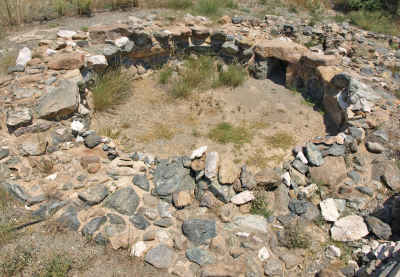
Yerokambos II Tholos Tomb
West of Lendas, Crete, Greece
Photo: Ian Swindale
West of Lendas, Crete, Greece
Photo: Ian Swindale
Since their discovery many have wondered if these ancient round buildings could have had fully vaulted stone domes like the well-known monumental subterranean Mycenaean tholos tombs on the mainland but the roofs of the Minoan tholoi had long since been dismantled and destroyed. On examination many of the ruined tholos walls that did remain showed an intriguing inward tilt insinuating a possible stone dome.
Many years of speculation and discussion ensued mainly centered around the tholoi having roofs consisting of wood and mud or being fully vaulted in stone. In 1970 Branigan proposed the tombs may have had a light, wooden flat roof. But those arguing for a flat or domed wooden and mud roof were countered by the fact no evidence of any stone or wooden supports which would have been necessary to span the walls of the larger tombs with beams has ever been found. Also no decomposed wood or mud has been discovered at any of these sites. Those supporting the roofs as stone domes were countered with the unsubstantiated argument the circular walls were far too thin to hold the great weight of the stone required.
In the 1970's a smaller tholos tomb (Tholos Tomb Gamma) with a well preserved stone dome was discovered in the Archanes cemetery of Phourni providing clear evidence that at least the smaller tombs were probably fully vaulted in stone. Importantly in 1976 Pelon published the measurements of some 44 tholos tombs providing a solid foundation for future study and analysis.
A big, but seriously flawed, step in the right direction on this question was made by Cavanagh and Laxton beginning in 1981 when they attempted to define the underlying structural mechanics of the construction of the subterranean Mycenaean and above-ground Minoan tholos tombs. Unfortunately their assumption that tholos construction was based on the principle of the simple corbelled arch which relied on vertical compression only was invalid. While this is highly intuitive and the corbelled arch was an important construction technique among the ancients as we shall see this is far from the only compressive force acting on these structures.
This omission led them to believe the Mycenaean and Minoan tholoi were built using unrelated construction techniques and to predict the wall thickness of the Minoan tombs should be about half (0.53) that of the interior radius. Almost all of the tholoi walls measured by Pelon were thinner than this so for a short time the pendulum swung toward the view that none of the Minoan tholoi could have been fully vaulted in stone and they must have had wooden and mud-based flat or dome shaped roofs.
Santillo Frizell and Santillo took exception to Cavanagh and Laxton's hypothesis in 1984 arguing the structural behavior of the tholoi was consistent with that of a "true" masonry dome. Then in 1988 the renowned archaeologist Keith Branigan published an updated edition of his earlier superb work on the Mesara tholoi where he reasoned that after analyzing the Archanes tholoi and other structures most if not all of the Minoan tholos tombs were in fact completely vaulted in stone. Subsequently L. Vance Watrous came to this same conclusion and strongly endorsed Branigan's determination in 1994.
In another serious setback for Cavanagh and Laxton's tholos corbelling theory, Cremasco and Laffineur published in 1999 an examination of the partially collapsed dome of Thorikos in southern Attica based on linear elasticity which is the mathematical study of how solid materials modeled as continua are internally stressed due to loading using the method of finite elements analysis. Linear elasticity is a special case of the general theory of nonlinear elasticity from continuum mechanics that is valid only for stress states (infinitesimal strains) that do not produce any yielding or permanent deformation. It is used extensively in modern structural analysis and engineering design. One of the findings of this study was the detection of tensile stresses along the ring of the dome's base (springer) which is inconsistent with simple corbelling (Como, 2006).
Over the years attention was focused on the structures throughout the Mediterranean that obviously used the same circular tholos construction technique to one degree or the other in order to discover the true nature of how these incredibly strong and resilient buildings were made. This included the Minoan tholos tombs on Crete, the Millaren and El Argar tholos structures in Spain, the Nuraghic fortresses and well temples in Sardinia, and the Mycenaean tholoi in Greece. Many of these structures have endured for well over 3,000 years and yet in some cases have come down to us very well preserved. This is especially true for the so called Treasury (Tholos) of Atreus at Mycenae in Greece and the exquisite Santa Cristina well temple in Sardinia.
A great deal of work was performed in analyzing the tholos domes using Bayesian and other statistical techniques, but they all made the same mistake in limiting their study to a dome's vertical compressive forces only in cross-sectional slices as a corbelled arch. None of the publications produced from these efforts conclusively identified how the structures were actually built and especially why they were so strong and durable. Vertical compression alone was simply not enough to explain the powerful structural integrity of these buildings.
As time moved on many came to the uneasy realization that after several decades of discussion and debate, claims and counterclaims, and thirty years of analytical attempts to decipher their mysteries no one definitively understood how the tholoi were constructed and especially why they were strong enough to endure sometimes significant ground shaking from earthquake activity over a period of thousands of years. Into this murky situation came Maria Teresa Como who began to very closely examine one of the tholos structures most likely to reveal its secrets - the monumental Tholos of Atreus at Mycenae.
Many years of speculation and discussion ensued mainly centered around the tholoi having roofs consisting of wood and mud or being fully vaulted in stone. In 1970 Branigan proposed the tombs may have had a light, wooden flat roof. But those arguing for a flat or domed wooden and mud roof were countered by the fact no evidence of any stone or wooden supports which would have been necessary to span the walls of the larger tombs with beams has ever been found. Also no decomposed wood or mud has been discovered at any of these sites. Those supporting the roofs as stone domes were countered with the unsubstantiated argument the circular walls were far too thin to hold the great weight of the stone required.
In the 1970's a smaller tholos tomb (Tholos Tomb Gamma) with a well preserved stone dome was discovered in the Archanes cemetery of Phourni providing clear evidence that at least the smaller tombs were probably fully vaulted in stone. Importantly in 1976 Pelon published the measurements of some 44 tholos tombs providing a solid foundation for future study and analysis.
A big, but seriously flawed, step in the right direction on this question was made by Cavanagh and Laxton beginning in 1981 when they attempted to define the underlying structural mechanics of the construction of the subterranean Mycenaean and above-ground Minoan tholos tombs. Unfortunately their assumption that tholos construction was based on the principle of the simple corbelled arch which relied on vertical compression only was invalid. While this is highly intuitive and the corbelled arch was an important construction technique among the ancients as we shall see this is far from the only compressive force acting on these structures.
This omission led them to believe the Mycenaean and Minoan tholoi were built using unrelated construction techniques and to predict the wall thickness of the Minoan tombs should be about half (0.53) that of the interior radius. Almost all of the tholoi walls measured by Pelon were thinner than this so for a short time the pendulum swung toward the view that none of the Minoan tholoi could have been fully vaulted in stone and they must have had wooden and mud-based flat or dome shaped roofs.
Santillo Frizell and Santillo took exception to Cavanagh and Laxton's hypothesis in 1984 arguing the structural behavior of the tholoi was consistent with that of a "true" masonry dome. Then in 1988 the renowned archaeologist Keith Branigan published an updated edition of his earlier superb work on the Mesara tholoi where he reasoned that after analyzing the Archanes tholoi and other structures most if not all of the Minoan tholos tombs were in fact completely vaulted in stone. Subsequently L. Vance Watrous came to this same conclusion and strongly endorsed Branigan's determination in 1994.
In another serious setback for Cavanagh and Laxton's tholos corbelling theory, Cremasco and Laffineur published in 1999 an examination of the partially collapsed dome of Thorikos in southern Attica based on linear elasticity which is the mathematical study of how solid materials modeled as continua are internally stressed due to loading using the method of finite elements analysis. Linear elasticity is a special case of the general theory of nonlinear elasticity from continuum mechanics that is valid only for stress states (infinitesimal strains) that do not produce any yielding or permanent deformation. It is used extensively in modern structural analysis and engineering design. One of the findings of this study was the detection of tensile stresses along the ring of the dome's base (springer) which is inconsistent with simple corbelling (Como, 2006).
Over the years attention was focused on the structures throughout the Mediterranean that obviously used the same circular tholos construction technique to one degree or the other in order to discover the true nature of how these incredibly strong and resilient buildings were made. This included the Minoan tholos tombs on Crete, the Millaren and El Argar tholos structures in Spain, the Nuraghic fortresses and well temples in Sardinia, and the Mycenaean tholoi in Greece. Many of these structures have endured for well over 3,000 years and yet in some cases have come down to us very well preserved. This is especially true for the so called Treasury (Tholos) of Atreus at Mycenae in Greece and the exquisite Santa Cristina well temple in Sardinia.
A great deal of work was performed in analyzing the tholos domes using Bayesian and other statistical techniques, but they all made the same mistake in limiting their study to a dome's vertical compressive forces only in cross-sectional slices as a corbelled arch. None of the publications produced from these efforts conclusively identified how the structures were actually built and especially why they were so strong and durable. Vertical compression alone was simply not enough to explain the powerful structural integrity of these buildings.
As time moved on many came to the uneasy realization that after several decades of discussion and debate, claims and counterclaims, and thirty years of analytical attempts to decipher their mysteries no one definitively understood how the tholoi were constructed and especially why they were strong enough to endure sometimes significant ground shaking from earthquake activity over a period of thousands of years. Into this murky situation came Maria Teresa Como who began to very closely examine one of the tholos structures most likely to reveal its secrets - the monumental Tholos of Atreus at Mycenae.
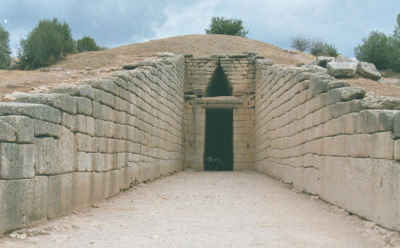
Tholos of Atreus
Mycenae, Greece
Mycenae, Greece
This large tholos' interior walls were constructed of finely worked stones laid down as 22 separate horizontal concentric masonry rings each slightly cantilevered inward one on top of the other like a layer cake up to the dome's apex. It's the most studied of all tholoi with a good deal of scientific literature devoted to it over the last 180 years. Como was able to effectively model the exterior of the dome's masonry even though it's covered with an earth mound by studying sections of the structure that were temporarily visible to scholars in the past. Her structural analysis conclusively demonstrated the failure of the corbelling principle of vertical compression only and finally revealed the secret of the dome's true behavior.
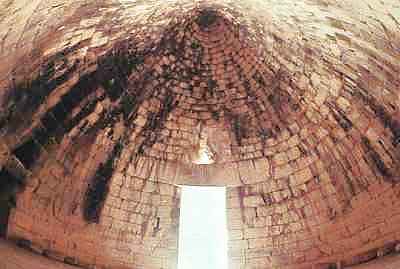
Tholos of Atreus
Interior View of Vault and Entrance
Mycenae, Greece
Interior View of Vault and Entrance
Mycenae, Greece
The tholos masonry rings were constructed to be as horizontally incompressible as possible with smaller stones acting as wedges forced into the spaces between the larger ones to enforce the dome's radial rigidity. Just as gravity forces the dome as a whole into vertical compression it pulls inward on the slightly cantilevered inner edge of each masonry ring to drive it into horizontal radial compression forcing the dome to behave like a tightly bound stone membrane (Como, 2006).
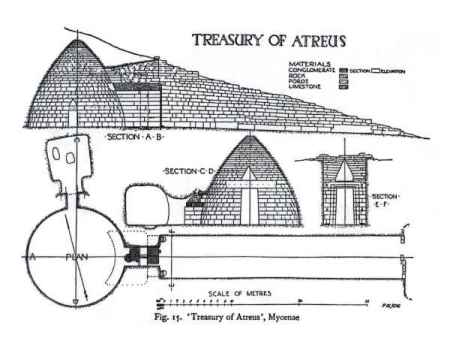
Tholos of Atreus Sectionals
Mycenae, Greece
Artist: Piet de Jong
Mycenae, Greece
Artist: Piet de Jong
This is the behavior of a "true" dome, not a false or pseudo-dome. Apparently the true tholos dome using the horizontal ring arch not only came first but it came nearly three thousand years before the vertical roman masonry arch. The semicircular roman "true" arch was quite probably derived from the horizontal tholos ring. A tholos ring arch can easily be theoretically visualized as two vertical semicircular roman arches joined into a complete circle, laid horizontally, and concentrically stacked to form a dome with tremendous strength and resiliency. As long as the radial incompressibility of the rings is enforced during construction it doesn't matter if the stones used are finely sculpted or completely unworked and hand-fitted.
A Definition of Tholos Structural Mechanics
A tholos dome can be simply defined and ideally visualized as a stack of infinitesimally thin horizontally and vertically incompressible stone rings with slightly cantilevered inner edges and infinite contact friction centered on a vertical line parallel to gravity with a cross-sectional profile generally conforming to the shape of an inverted "catenary" curve to create a fully vaulted true stone dome. The catenary profile is the ideal mathematical form for bearing a maximum of weight with the least amount of material. It's the strongest form of arch or vault known to physics and is modeled on the curve made by a free-hanging idealized string of beads when supported at its ends which assumes the variable U-like shape of the hyperbolic cosine function: f(x) = a cosh (x/a).
In modern times the catenary form has been used by architects like Antoni Gaudi who incorporated it in several of his beautiful structural designs in Spain. An elegant modern example of a "weighted" or "flattened" version of the catenary form is the Gateway Arch in St. Louis in the United States. While an ideal catenary has constant thickness, as the top is approached the Gateway Arch becomes thinner.
In modern times the catenary form has been used by architects like Antoni Gaudi who incorporated it in several of his beautiful structural designs in Spain. An elegant modern example of a "weighted" or "flattened" version of the catenary form is the Gateway Arch in St. Louis in the United States. While an ideal catenary has constant thickness, as the top is approached the Gateway Arch becomes thinner.
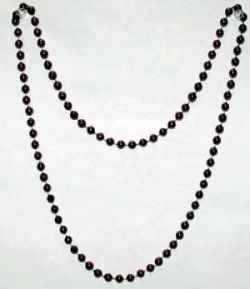
Hanging String of Beads
Forming Two Catenary Curves
Forming Two Catenary Curves

Graph of Hyperbolic Cosine Function
Y = A Cosh (X/A)
Y = A Cosh (X/A)

Gateway Arch
St. Louis, Missouri, USA
St. Louis, Missouri, USA
These are the two great secrets of tholos construction and why these structures have been so successful in enduring for so long - the technique of horizontal ringed incompressibility and the form of the mathematically ideal catenary curve. The theoretical concept of the tholos is so inherently strong that you could build up its circular walls to any arbitrary height and do whatever you wished with the dome's top. You could leave it open to the sky, completely vault it in stone, or have a team of oxen drag a large capstone over the opening to permanently roof it as was done at the subterranean El Romeral tholos in Antequera, Spain.
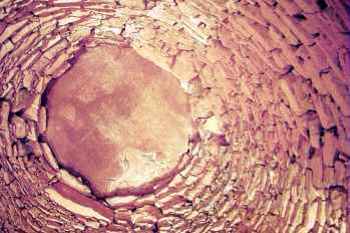
El Romeral Tholos Interior View
Vault Capped with Large Capstone
Antequera, Spain
Vault Capped with Large Capstone
Antequera, Spain
Also you could completely cover it with an earthen mound which would only drive it further into compression or build multi-story tholos vaults one on top of the other as in the large Sardinian watchtower fortresses like Santu Antine just south of Torralba.
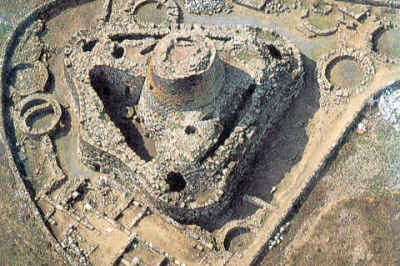
Santu Antine Watchtower Fortress
Torralba, Sardinia
Torralba, Sardinia

Santu Antine Watchtower Fortress
Sectional Diagram Torralba, Sardinia
Sectional Diagram Torralba, Sardinia
The Origination of the Tholos
With tholos construction being such a curiosity for so long it's no wonder there has been a great deal of discussion and speculation about the identity of their first appearance. The structures we can be most certain of being the first true tholoi in the archaeology are the Minoan tombs from the end of the Final Neolithic period on the southern slopes of the Asterousia mountains in south-central Crete. Several other candidates have been suggested over the years. The most credible of these are the very ancient circular neolithic structures from Khirokitia on Cyprus of the 7th Millennium BC and the Halafian mudbrick so called "tholoi" of Arpachiyah in Syria from the 5th Millennium BC.

Round Neolithic Structures
Modern Reconstruction
Khirokitia, Cyprus
Modern Reconstruction
Khirokitia, Cyprus
No evidence has ever been found to support the contention these domestic Halafian and Khirokitian structures were anything other than simply vertically-walled round buildings. The Halafian structures predated the tholoi on Crete by about 1,000 years and those from Khirokitia are much older. The chronological disconnection is profound and round construction alone does not imply the catenary vaulting of a domed tholos. In fact the burnt remains of a collapsed flat roof made of twigs and mud has been found at Khirokitia. The fragments of this roof are on display at the museum in Larnaka. The first stone vaulted tholos dome can securely be assumed to have been built on the island of Crete in the Aegean during the 4th Millennium BC and not earlier.
The Cob (Mud) Tholos
It's quite possible the Cretan stone tholos was originally derived from domed buildings made of cob (mud) modeled on the catenary form. Cob typically consists of a mixture of clay, sand, straw, water, and earth. It's well known that a tholos made from specially prepared cob can be effectively built using the same structural principles as the stone version. The modern Musgum people, a group in Cameroon, Africa build quite tall (up to 9 meters) tholos-like domed structures ('cases obos') that closely approximate the catenary form using compressed and shaped sun-dried cob. Cob construction is still widely used around the world because the materials are normally readily available and it requires no tools.

Musgum Cob (Mud) Tholos
Cameroon, Africa
Cameroon, Africa
During construction the workers lay down their loaves of cob spirally until a solid ring of about a half of a meter (1.6 ft) high is complete and then let the ring completely set and dry before beginning work on the next one up. They leave a circular opening to the sky at the summit. Interestingly, raised patterns are built on the side of the buildings that allow for rain runoff and provide a secure foothold for workers during construction and for regular maintenance over the entire exterior of the building. The genius on Crete that invented the stone catenary tholos would probably have first experimented with the technique using relatively incompressible cob before building a structure like the impressive stone Yerokambos II tomb.
A System of Architectural Education
The tholos technique is so inscrutable and counter-intuitive that typically no one would ever be able to build one of these structures by just closely observing them as could easily be done with the very intuitive and widely used techniques of "post and lintel" and corbelled arch construction that involved nothing more than the simple stacking and cantilevering of stones.
In order to master the complexity of the tholos technique an initiate would most probably have to attend a rigorous system of architectural education and engage in an extensive apprenticeship to acquire all the skills necessary to confidently build them. Students of this curriculum would have learned all of the construction techniques of their time but the tholos would have been their most demanding and curious subject.
At some point after their original construction the society in the area must have placed a good deal of value on this new addition to their architectural palette. It would have been absolutely necessary to create a strong system of enduring education in order to sustain the theoretical knowledge of the tholos throughout many generations over a period of more than two thousand years.
No matter how loosely organized or highly centralized this implied system of education was as a whole it would have most probably included the other major disciplines and skill-sets important to the time - metalworking, shipbuilding, etc. The intricacies of these subjects would have demanded years of training and apprenticeship to achieve mastery. This ancient system of continuous knowledge would have been highly valued and tightly bound to the culture that originated and nurtured it. By following the geo-chronological appearance of these tholos structures you are also tracking the cultural continuity of the educational tradition that sustained them.
In order to master the complexity of the tholos technique an initiate would most probably have to attend a rigorous system of architectural education and engage in an extensive apprenticeship to acquire all the skills necessary to confidently build them. Students of this curriculum would have learned all of the construction techniques of their time but the tholos would have been their most demanding and curious subject.
At some point after their original construction the society in the area must have placed a good deal of value on this new addition to their architectural palette. It would have been absolutely necessary to create a strong system of enduring education in order to sustain the theoretical knowledge of the tholos throughout many generations over a period of more than two thousand years.
No matter how loosely organized or highly centralized this implied system of education was as a whole it would have most probably included the other major disciplines and skill-sets important to the time - metalworking, shipbuilding, etc. The intricacies of these subjects would have demanded years of training and apprenticeship to achieve mastery. This ancient system of continuous knowledge would have been highly valued and tightly bound to the culture that originated and nurtured it. By following the geo-chronological appearance of these tholos structures you are also tracking the cultural continuity of the educational tradition that sustained them.
The Geo-Chronology of the Minoan Tholos
With this in mind I began to map the geo-chronological appearance of the tholos' "cultural signature" throughout the greater Mediterranean and Europe in 2007. At the time I was quite surprised by what I found. Very soon after the tholos' appearance as tombs on Crete they were constructed for the same purpose in southeastern Spain among the Los Millares.

Los Millares Tholos Tombs
near Santa Fe de Mondujar, Almeria, Andalusia, Spain
near Santa Fe de Mondujar, Almeria, Andalusia, Spain
After the fall of the Los Millares (about 2300 or 2200 BC) the tholos was transformed into large defensive watchtower fortresses by the El Argar (ex: Motilla del Azuer near Daimiel in central Spain).

Motilla del Azuer Tholos Watchtower Fortress
near Daimiel, Castilla-La Manche, Spain
near Daimiel, Castilla-La Manche, Spain
When the defenders were well prepared and provisioned these structures were almost unassailable given the military technology of the time. The key to surviving a long siege in them was the presence of a permanent source of water. The Motilla del Azuer features the oldest water well ever found in Iberia. The motillas in Spain were abandoned sometime between 1500 and 1350 BC, but hundreds of years earlier beginning in about 2000 BC they had started to appear in Sardinia. By the 13th century BC tholos structures blanketed the island in great profusion. Sardinia has the highest concentration of tholos structures known with literally thousands of them still dotting the landscape. Sardinia must have experienced repeated raids and invasions from the sea for hundreds of years for them to build all of these fortresses and watchtowers. Towards the end of the Bronze Age they began to symbolically express the close association of their life-giving water wells and tholos fortresses by building several completely unique subterranean tholos well temples.
Curiously, mainland Greece did not see the appearance of structures using the tholos technique until about 1600 BC a few hundred years after the beginning of their construction on Sardinia. It's thought the first tholos tomb built on the mainland was in the southwestern part of the Peloponnese peninsula in Messenia (Koryphasion, Pylos, etc.) at the end of the Middle Helladic period. This is closely synchronous to the time of the massive eruption of the Santorini (Thera) marine volcano and Late Minoan IB Destruction event on Crete.
It's not known who actually built the first tholoi in Messenia but it seems much more probable that Minoan refugees escaping the volcanic devastation in the Aegean carried the tholos knowledge base with them to the Peloponnese. Apparently throughout the very long period of many hundreds of years of Minoan maritime domination in the eastern Mediterranean they did not share the knowledge of the tholos with the peoples on the mainland. But it appears this knowledge and the educational system that supported it were soon adopted and embraced by the only significant power left in the Aegean after the great Santorini eruption - the Mycenaeans. Within a period of only some decades, in about 1550 or 1525 BC, they started building tholoi at Mycenae.
The period of Mycenaean tholos construction lasted for only some three hundred years until about 1250 or 1230 BC when they became the first of the Bronze Age powers in the eastern Mediterranean to be utterly destroyed by the Sea Peoples. The tholos continued to be built by the Sardinians and on the Greek mainland by others well into the eastern Mediterranean Iron Age.
Curiously, mainland Greece did not see the appearance of structures using the tholos technique until about 1600 BC a few hundred years after the beginning of their construction on Sardinia. It's thought the first tholos tomb built on the mainland was in the southwestern part of the Peloponnese peninsula in Messenia (Koryphasion, Pylos, etc.) at the end of the Middle Helladic period. This is closely synchronous to the time of the massive eruption of the Santorini (Thera) marine volcano and Late Minoan IB Destruction event on Crete.
It's not known who actually built the first tholoi in Messenia but it seems much more probable that Minoan refugees escaping the volcanic devastation in the Aegean carried the tholos knowledge base with them to the Peloponnese. Apparently throughout the very long period of many hundreds of years of Minoan maritime domination in the eastern Mediterranean they did not share the knowledge of the tholos with the peoples on the mainland. But it appears this knowledge and the educational system that supported it were soon adopted and embraced by the only significant power left in the Aegean after the great Santorini eruption - the Mycenaeans. Within a period of only some decades, in about 1550 or 1525 BC, they started building tholoi at Mycenae.
The period of Mycenaean tholos construction lasted for only some three hundred years until about 1250 or 1230 BC when they became the first of the Bronze Age powers in the eastern Mediterranean to be utterly destroyed by the Sea Peoples. The tholos continued to be built by the Sardinians and on the Greek mainland by others well into the eastern Mediterranean Iron Age.
The Sardinian Tholos Well Temple
Throughout the entire period of tholos construction up to the end of the Bronze Age all of the different types of structures built using the technique were totally dedicated to some practical functionality either as
tombs, watchtowers, or fortresses except for one - the Nuraghic tholos well temples on Sardinia. They had no practical function at all. While they could have been used as a source of fresh water there's absolutely no reason to expensively cover the well with a subterranean tholos vault approached by a descending dromos stairway. Throughout this period they were the only purely symbolic tholos structures ever constructed and they can be found exclusively on Sardinia with one very notable exception - the Garlo well temple west of Sofia in Bulgaria.
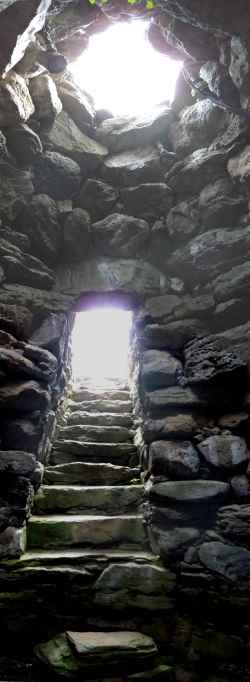
Sant'Anastasia Well Temple
Interior View of Dromos and Top Opening
Sardara, Sardinia
Photo: R. S. Roberto
Interior View of Dromos and Top Opening
Sardara, Sardinia
Photo: R. S. Roberto

Funtana Coberta Well Temple
View into Dromos with WSW Orientation
near Ballao, Sardinia
Photo: R. S. Roberto
View into Dromos with WSW Orientation
near Ballao, Sardinia
Photo: R. S. Roberto
The Sardinian well temple typology is quite simple. The tholos vault was subterranean with a water well set in the center of it's floor and a sometimes quite small opening at the vault's apex allowing the light of the sun, moon, and stars to enter the chamber. It was entered by an invariably straight descending dromos stairway that was typically orientated variably somewhere between East South East and West South West.

Santa Cristina Well Temple
with SSE Dromos Orientation
near Paulilatino, Sardinia
Photo: Andi Buchner
with SSE Dromos Orientation
near Paulilatino, Sardinia
Photo: Andi Buchner
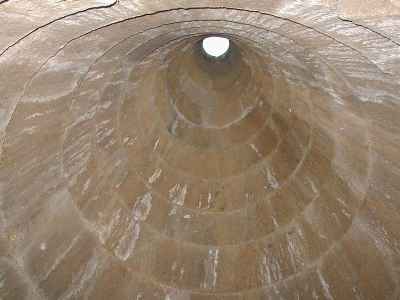
Santa Cristina Well Temple
Interior View of Tholos Vault Apex
near Paulilatino, Sardinia
Interior View of Tholos Vault Apex
near Paulilatino, Sardinia
The Garlo Tholos Well Temple in Western Bulgaria
The subterranean tholos well structure at Garlo is close to the headwaters of the Struma river about 40 kilometers WNW of Sofia. The Struma flows southward draining into the Aegean Sea near modern Amfipoli in northern Greece. The site was discovered in 1972 by the Bulgarian archaeologist Dimitrina Mitova-Djonova. Its typology is identical to the many Late Bronze Age Nuraghic tholos well temples on Sardinia and appears to have been built at about the same time as the stunning, finely-worked Santa Cristina well temple - the end of the Bronze Age.
Efforts to preserve and restore the site began in 1984. At this early time despite the claims of some no one had an accurate conception of the form and technique used to build a tholos vault so any work to restore them to their original condition was doomed to conjecture and ultimate failure. From her excavation drawing Mitova-Djonova assumed the vault to be hemispherical. This would have seemed a highly valid possibility in the 1980s but a hemispherical vault is an inherently weaker form than the catenary and requires a construction material stronger than radially compressed roughly worked stone.
Efforts to preserve and restore the site began in 1984. At this early time despite the claims of some no one had an accurate conception of the form and technique used to build a tholos vault so any work to restore them to their original condition was doomed to conjecture and ultimate failure. From her excavation drawing Mitova-Djonova assumed the vault to be hemispherical. This would have seemed a highly valid possibility in the 1980s but a hemispherical vault is an inherently weaker form than the catenary and requires a construction material stronger than radially compressed roughly worked stone.

Garlo Well Temple - Sectional Drawing
showing Hemispherical Vault
Credit: D. Mitova-Djonova, 1984
showing Hemispherical Vault
Credit: D. Mitova-Djonova, 1984
Stone or concrete hemispherical domes weren't built until the Roman era. The first true vault of this type that's known to me is the "Temple of Mercury" in Baiae, Italy built in the late 1st century BC at about the time of Augustus. It's constructed of roman concrete poured into wooden forms. The Pantheon in Rome is also a concrete
hemispherical vault built in the 2nd century AD. So it can be safely assumed this type of vault was not attempted
in Garlo's much earlier Bronze Age vault. Garlo would have been modeled on the well-known, tried, and true catenary form which had been in use for thousands of years by the time of it's construction.

Garlo Well Temple
Showing Modern Reconstructed Vertical Wall
above the Curve of the Original Tholos
Photo: L. Tsonev
Showing Modern Reconstructed Vertical Wall
above the Curve of the Original Tholos
Photo: L. Tsonev
On examining Garlo's current condition it's evident an earlier attempt to restore the tholos vault was
unsuccessful. Without the knowledge of the catenary form or the technique of "horizontal ringed incompressibility" it would have been impossible for the reconstruction crew to accurately restore the vault to its original state. While the top of the vault was found to be heavily damaged during the excavation you can see a straightening of the slope of the walls sitting on top of the remnants of the original inward leaning tholos walls from the shadows in the above image. I'm sure in spite of their very best efforts to recreate the upper part of the vault the restorers were reduced to building a vertically walled cylinder on top of the original tholos that is now a gaping hole exposed to the elements.
Garlo also has an apparent error at the beginning of the dromos' southern oriented stairway. There is a short hard right-angle turn to the east for the first few steps downward into the well. This should not be! To the best of my knowledge no other tholos/dromos structure ever built including all of the Sardinian well temples has anything resembling a hard 90 degree turn in the dromos. The excavation drawings indicate no such turn was found when the dromos first came to light.
Garlo also has an apparent error at the beginning of the dromos' southern oriented stairway. There is a short hard right-angle turn to the east for the first few steps downward into the well. This should not be! To the best of my knowledge no other tholos/dromos structure ever built including all of the Sardinian well temples has anything resembling a hard 90 degree turn in the dromos. The excavation drawings indicate no such turn was found when the dromos first came to light.
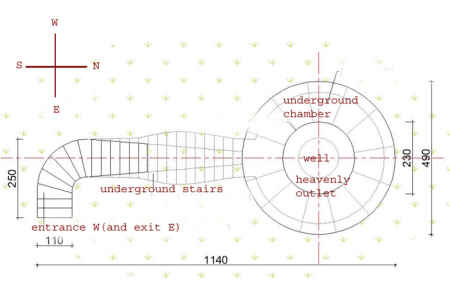
Garlo Well Temple
Current Reconstruction - Top View Layout
with Right Angle Turn to East at beginning of Dromos
Current Reconstruction - Top View Layout
with Right Angle Turn to East at beginning of Dromos

Garlo Well Temple
Top View Excavation Drawing
Credit: D. Mitova-Djonova, 1984
Top View Excavation Drawing
Credit: D. Mitova-Djonova, 1984
If you could somehow put Garlo almost anywhere on Sardinia it would be perfectly in place along side dozens of other Nuraghic tholos well temples and no one would ever raise the slightest question. But, almost freakishly, it oddly stands completely alone both chronologically and geographically as a stark singularity in the archaeology of the Balkans.
Swimming deeply in probabilities I believe the most reasonable scenario is that Garlo identifies a resettlement of Sardinians in a region of western Bulgaria just north of the Aegean known for it's mineral wealth in gold and silver at about the time of the fall of the Mycenaeans or the later cessation of the battles of the Sea Peoples. The probability that Garlo could be a place where a group of the Sea Peoples migrated to is simply too high to ignore. Garlo could very well turn out to be the first archaeological site ever relatively securely identified with a resettlement of a group of the Sea Peoples in Europe.
With a certainty this deeply misunderstood tholos structure will one day rightfully become a UNESCO world heritage site I believe a rigorous re-examination and analysis of the well temple and its associated excavated materials should be conducted. With Garlo built on the side of a hill, new precision measurements of the tholos vault will provide a basis for determining its most probable original dimensions and allow for the correction of any distortion of the structure from ground movement, etc. that has occurred over the last 3,200 years.
Special emphasis should be given to collecting potentially datable samples from the site and re-examining the available excavated materials for the purpose of obtaining a valid, accurate chronological dating of the site's original construction using the best and most appropriate dating methodologies available. Until the results are in I can only assume from very strong reasonable probability that Garlo is a resettlement of Sea Peoples in Europe at the end of the Bronze Age. If true, as an undeniable cultural expression of the tholos techniques of the Bronze Age Nuraghic Sardinians it should be recognized as the wonderfully unique Bulgarian archaeological world treasure it is.
Swimming deeply in probabilities I believe the most reasonable scenario is that Garlo identifies a resettlement of Sardinians in a region of western Bulgaria just north of the Aegean known for it's mineral wealth in gold and silver at about the time of the fall of the Mycenaeans or the later cessation of the battles of the Sea Peoples. The probability that Garlo could be a place where a group of the Sea Peoples migrated to is simply too high to ignore. Garlo could very well turn out to be the first archaeological site ever relatively securely identified with a resettlement of a group of the Sea Peoples in Europe.
With a certainty this deeply misunderstood tholos structure will one day rightfully become a UNESCO world heritage site I believe a rigorous re-examination and analysis of the well temple and its associated excavated materials should be conducted. With Garlo built on the side of a hill, new precision measurements of the tholos vault will provide a basis for determining its most probable original dimensions and allow for the correction of any distortion of the structure from ground movement, etc. that has occurred over the last 3,200 years.
Special emphasis should be given to collecting potentially datable samples from the site and re-examining the available excavated materials for the purpose of obtaining a valid, accurate chronological dating of the site's original construction using the best and most appropriate dating methodologies available. Until the results are in I can only assume from very strong reasonable probability that Garlo is a resettlement of Sea Peoples in Europe at the end of the Bronze Age. If true, as an undeniable cultural expression of the tholos techniques of the Bronze Age Nuraghic Sardinians it should be recognized as the wonderfully unique Bulgarian archaeological world treasure it is.
June, 2011
Acknowledgments:
I want to especially convey my great thanks to Zhoro Martinov for introducing me to the Garlo well temple and for his dedication in advancing the research on this stunning archaeological site. Also, this paper would not be as complete as it is without the excellent efforts of my colleagues at the Academy of Sciences in Sofia, Bulgaria. Much thanks to you all!
I want to especially convey my great thanks to Zhoro Martinov for introducing me to the Garlo well temple and for his dedication in advancing the research on this stunning archaeological site. Also, this paper would not be as complete as it is without the excellent efforts of my colleagues at the Academy of Sciences in Sofia, Bulgaria. Much thanks to you all!
Bibliography:
Belli, P., 2003, "On Measuring Tholoi in the Aegean Bronze Age", in K. P. Foster and R. Laffineur (eds.), Metron: Measuring the Aegean Bronze Age [Aegaeum 24] (Liege/Austin), pp. 403-409.
Branigan, K., 1970, "The Tombs of Mesara", London.
Branigan, K., 1975, "The Tombs of Mesara: New Tombs and New Evidence", BICS 22, pp. 200-203.
Branigan, K., 1984, "Early Minoan Society: the Evidence of the Mesara Tholoi Revised", in Aux Origines de l'Hellenisme: La Crete et la Grece. Hommages a Henri Van Effenterre (Paris), pp. 29-37.
Branigan, K., 1988, "Pre-Palatial. The Foundations of Palatial Crete. A Survey of Crete in the Early Bronze Age", (2nd updated Edition), London.
Branigan, K., 1994, "The Corbelling Controversy - Another Contribution", Cretan Studies 4, pp. 65-69.
Cavanagh, W. G. and Laxton, R. R., 1981, "The Structural Mechanics of the Mycenaean Tholos Tomb", BSA 76, pp. 109-140.
Cavanagh, W. G. and Laxton, R. R., 1982, "Corbelling in the Late Minoan Tholos Tombs", BSA 77, pp. 109-140.
Cavanagh, W. G. and Laxton, R. R., 1985, "Corbelled Vaulting in Mycenaean Tholos Tomb and Sardinian Nuraghi", in C. Malone and S. Stoddart (eds.), Papers in Italian Archaelogy, IV Part iii, Oxford, British Archaeological Reports, International Series, 245, pp. 413 - 433.
Cavanagh, W. G. and Laxton, R. R., 1988, "Problem Solving and the Architecture of Tholos Tombs", in E. B. French and K. A. Wardle (eds.), Problems in Greek Prehistory (Bristol), pp. 385-395.
Cavanagh, W. and Mee, C., 1998, "A Private Place: Death in Prehistoric Greece", [SIMA 125] (Jonsered), pp. 41-60.
Cavanagh, W. and Mee, C., 1999, "Building the Treasury of Atreus", in P. P. Betancourt, V. Karageorghis, R. Laffineur, and W.-D. Niemeier (eds.), MELETEMATA: Studies in Aegean Archaeology Presented to Malcolm H. Wiener as He Enters His 65th Year [Aegaeum 20] (Liege/Austin), pp. 93-102.
Como, M. T., 2006, "Analysis of the Statics of Mycenaean tholoi", Proceedings of the Second International Congress on Construction History, Cambridge 29 March-2 April 2006, M. Dunkeld, J. Campbell, H.Louw, M. Tutton, B. Addis, C. Powell, R. Thorne edd., Exeter, Volume 1, pp.777-790.
Como, M. T., 2008, "The technical expertise used in the stability of the Mycenaean Tholos", in S. D'Agostino (Ed.), History of Engineering. Proceedings of the 2nd National Conference, Naples 7-8-9 April 2008, Naples, pp. 717-726.
Como, M. T., 2009, "The Construction of Mycenaean tholoi", in Kurrer KE, W. Lorenz, V. Wetzk (Edd.), Proceedings of the Third International Congress on Construction History, Brandenburg University of Technology Cottbus, May 20-24, 2009, Berlin, Volume 1, pp.385-391.
Cremasco, V and Laffineur, R., 1999, "The Engineering of Mycenaean Tholoi - The Circular Tomb at Thorikos Revisited", in Meletemata: Studies in Aegean Archaeology, Aegeum, 20, pp.139-148.
Hood, S., 1960, "Tholos Tombs of the Aegean," Antiquity 34, pp. 166-176.
Lazar, N. A., Kadane, J. B., Chen, F., Cavanagh, W. G., and Litton, C. D., 2004, "Corbelled Domes in Two and Three Dimensions: The Treasury of Atreus", International Statistical Review, 72, pp. 239-255.
Maggidis, C., "Burial Building 19, Phourni (Archanes): Variety and Originality in MM I Burial Architecture", in Pepragmena tou Z' Diethnous Archaiologikou Synedriou A2 (Rethymno 1995), pp. 562-575.
Mitova-Dzhonova, Dimitrina, "Megalithic Well Temple near the Village Garlo, District of Pernik", National Institute for Monuments of Culture, Sofia, 1984.
Papadatos, Y., 2005. "Tholos Tomb Gamma, A Prepalatial Tholos Tomb at Phourni, Archanes", With a contribution by Sevi Triantaphyllou". Philadelphia, PA: INSTAP Academic Press, Pp. xvii, 87; ills. 29, tables 19, pls. 22.
Pelon, O., 1976: Tholoi, tumuli et cercles funeraires. Recherches sur les monuments funeraires de plan circulaire dans l'Egee de l'age du Bronze (IIIe et IIe millenaires av. J. - C.). Paris-Athenes: BEFAR 229.
Pelon, O., 1998, "Les toimbes circulaires dans l'Egee de l'age du Bronze: etat des recherches sur les tombes a tholos," Topoi 8, pp. 95-158.
Sakellarakis, Y. and E., 1997, "Archanes : Minoan Crete in a new light", Athens.
Warren, P. M., 1973, "The Mitata of Nidha and Early Minoan Tholos Tombs", AAA 6, pp. 449-456.
Watrous, L.V. et al., 1993, "A Survey of the Western Mesara Plain in Crete: Preliminary Report of the 1984, 1986, and 1987 Field Season", Hesperia Vol. 62,, pp. 191-248.
Watrous, L.V., 1994, "Review of Aegean Prehistory III: Crete from Earliest Prehistory through the Protopalatial Period", AJA 98:4, pp. 695-753.
Belli, P., 2003, "On Measuring Tholoi in the Aegean Bronze Age", in K. P. Foster and R. Laffineur (eds.), Metron: Measuring the Aegean Bronze Age [Aegaeum 24] (Liege/Austin), pp. 403-409.
Branigan, K., 1970, "The Tombs of Mesara", London.
Branigan, K., 1975, "The Tombs of Mesara: New Tombs and New Evidence", BICS 22, pp. 200-203.
Branigan, K., 1984, "Early Minoan Society: the Evidence of the Mesara Tholoi Revised", in Aux Origines de l'Hellenisme: La Crete et la Grece. Hommages a Henri Van Effenterre (Paris), pp. 29-37.
Branigan, K., 1988, "Pre-Palatial. The Foundations of Palatial Crete. A Survey of Crete in the Early Bronze Age", (2nd updated Edition), London.
Branigan, K., 1994, "The Corbelling Controversy - Another Contribution", Cretan Studies 4, pp. 65-69.
Cavanagh, W. G. and Laxton, R. R., 1981, "The Structural Mechanics of the Mycenaean Tholos Tomb", BSA 76, pp. 109-140.
Cavanagh, W. G. and Laxton, R. R., 1982, "Corbelling in the Late Minoan Tholos Tombs", BSA 77, pp. 109-140.
Cavanagh, W. G. and Laxton, R. R., 1985, "Corbelled Vaulting in Mycenaean Tholos Tomb and Sardinian Nuraghi", in C. Malone and S. Stoddart (eds.), Papers in Italian Archaelogy, IV Part iii, Oxford, British Archaeological Reports, International Series, 245, pp. 413 - 433.
Cavanagh, W. G. and Laxton, R. R., 1988, "Problem Solving and the Architecture of Tholos Tombs", in E. B. French and K. A. Wardle (eds.), Problems in Greek Prehistory (Bristol), pp. 385-395.
Cavanagh, W. and Mee, C., 1998, "A Private Place: Death in Prehistoric Greece", [SIMA 125] (Jonsered), pp. 41-60.
Cavanagh, W. and Mee, C., 1999, "Building the Treasury of Atreus", in P. P. Betancourt, V. Karageorghis, R. Laffineur, and W.-D. Niemeier (eds.), MELETEMATA: Studies in Aegean Archaeology Presented to Malcolm H. Wiener as He Enters His 65th Year [Aegaeum 20] (Liege/Austin), pp. 93-102.
Como, M. T., 2006, "Analysis of the Statics of Mycenaean tholoi", Proceedings of the Second International Congress on Construction History, Cambridge 29 March-2 April 2006, M. Dunkeld, J. Campbell, H.Louw, M. Tutton, B. Addis, C. Powell, R. Thorne edd., Exeter, Volume 1, pp.777-790.
Como, M. T., 2008, "The technical expertise used in the stability of the Mycenaean Tholos", in S. D'Agostino (Ed.), History of Engineering. Proceedings of the 2nd National Conference, Naples 7-8-9 April 2008, Naples, pp. 717-726.
Como, M. T., 2009, "The Construction of Mycenaean tholoi", in Kurrer KE, W. Lorenz, V. Wetzk (Edd.), Proceedings of the Third International Congress on Construction History, Brandenburg University of Technology Cottbus, May 20-24, 2009, Berlin, Volume 1, pp.385-391.
Cremasco, V and Laffineur, R., 1999, "The Engineering of Mycenaean Tholoi - The Circular Tomb at Thorikos Revisited", in Meletemata: Studies in Aegean Archaeology, Aegeum, 20, pp.139-148.
Hood, S., 1960, "Tholos Tombs of the Aegean," Antiquity 34, pp. 166-176.
Lazar, N. A., Kadane, J. B., Chen, F., Cavanagh, W. G., and Litton, C. D., 2004, "Corbelled Domes in Two and Three Dimensions: The Treasury of Atreus", International Statistical Review, 72, pp. 239-255.
Maggidis, C., "Burial Building 19, Phourni (Archanes): Variety and Originality in MM I Burial Architecture", in Pepragmena tou Z' Diethnous Archaiologikou Synedriou A2 (Rethymno 1995), pp. 562-575.
Mitova-Dzhonova, Dimitrina, "Megalithic Well Temple near the Village Garlo, District of Pernik", National Institute for Monuments of Culture, Sofia, 1984.
Papadatos, Y., 2005. "Tholos Tomb Gamma, A Prepalatial Tholos Tomb at Phourni, Archanes", With a contribution by Sevi Triantaphyllou". Philadelphia, PA: INSTAP Academic Press, Pp. xvii, 87; ills. 29, tables 19, pls. 22.
Pelon, O., 1976: Tholoi, tumuli et cercles funeraires. Recherches sur les monuments funeraires de plan circulaire dans l'Egee de l'age du Bronze (IIIe et IIe millenaires av. J. - C.). Paris-Athenes: BEFAR 229.
Pelon, O., 1998, "Les toimbes circulaires dans l'Egee de l'age du Bronze: etat des recherches sur les tombes a tholos," Topoi 8, pp. 95-158.
Sakellarakis, Y. and E., 1997, "Archanes : Minoan Crete in a new light", Athens.
Warren, P. M., 1973, "The Mitata of Nidha and Early Minoan Tholos Tombs", AAA 6, pp. 449-456.
Watrous, L.V. et al., 1993, "A Survey of the Western Mesara Plain in Crete: Preliminary Report of the 1984, 1986, and 1987 Field Season", Hesperia Vol. 62,, pp. 191-248.
Watrous, L.V., 1994, "Review of Aegean Prehistory III: Crete from Earliest Prehistory through the Protopalatial Period", AJA 98:4, pp. 695-753.
W. Sheppard Baird
Copyright © 2007, 2024 W. Sheppard Baird
All Rights Reserved
All Rights Reserved
-

Knossos Palace Reconstruction
Crete, Greece
-
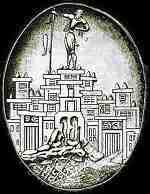
Master Seal Restoration
Chania, Crete, Greece
-

Spring Fresco West Wall
Swallows Scene
Akrotiri, Santorini (Thera), Greece
-

Minoan Ladies in Blue Fresco
Knossos, Crete, Greece
-
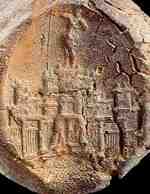
Master Seal Impression
Chania, Crete, Greece
-

Mediterranean Sea
-

Minoan Miniature Frieze
Admirals Flotilla Fresco
Shipping Scene Restoration
West House, Room 5, South Wall
Akrotiri, Santorini (Thera), Greece
-

Minoan Gold Ring
Crete, Greece
-

Mt. Pinatubo Eruption
Luzon, Phillipines, 1991
-

Minoan Bull Leaping Toreador Restoration Fresco
Knossos, Crete, Greece
-

Minoan Sea Daffodils Lilies Restoration Fresco
Akrotiri, Santorini (Thera), Greece
-

Minoan Boxing Boys Restoration Fresco
Akrotiri, Santorini (Thera), Greece
-

Minoan Antelope Restoration Fresco
Akrotiri, Santorini (Thera), Greece
-

Minoan Priest King
Feathered Prince of Lilies Fresco
Knossos, Crete, Greece
-

Minoan Sea Daffodils Lilies Fresco
Akrotiri, Santorini (Thera), Greece
-

Minoan Bull Leaping Toreador Fresco
Knossos, Crete, Greece
-

Minoan Antelope Fresco
Akrotiri, Santorini (Thera), Greece
-

Minoan Dolphins Fresco
Knossos, Crete, Greece
-

Minoan Gold Seal
Crete, Greece
-

Golden Ibex
Akrotiri, Santorini (Thera), Greece
-

Minoan Boxing Boys Fresco
Akrotiri, Santorini (Thera), Greece
-

Minoan Antelope Restoration Fresco
Akrotiri, Santorini (Thera), Greece
-

Minoan Sea Daffodils Lilies Restoration Fresco
Akrotiri, Santorini (Thera), Greece
-

Minoan Adorants Fresco Closeup
Akrotiri, Santorini (Thera), Greece
-
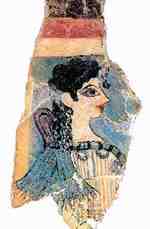
Minoan La Parisienne Fresco
Knossos, Crete, Greece
-

Minoan Blue Monkeys Fresco
Akrotiri, Santorini (Thera), Greece
-
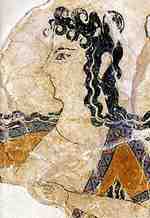
Minoan Dancer Fresco
Knossos, Crete, Greece
-
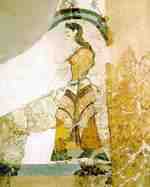
Minoan Lady with Papyri Fresco
Akrotiri, Santorini (Thera), Greece
-

Minoan Assembly on Hill Shipwreak Fresco
Akrotiri, Santorini (Thera), Greece
-

Minoan River Scene Fresco
Akrotiri, Santorini (Thera), Greece
-

Minoan Saffron Gatherers Fresco
Akrotiri, Santorini (Thera), Greece
-
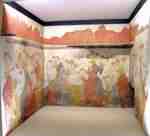
Minoan Spring Fresco
Akrotiri, Santorini (Thera), Greece
-
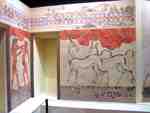
Minoan Fresco Art Exhibition
Akrotiri, Santorini (Thera), Greece
-
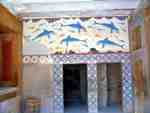
Minoan Dolphins Fresco Scene
Knossos, Crete, Greece